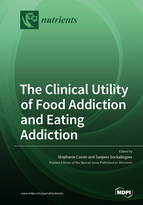The Clinical Utility of Food Addiction and Eating Addiction
A special issue of Nutrients (ISSN 2072-6643). This special issue belongs to the section "Clinical Nutrition".
Deadline for manuscript submissions: closed (1 November 2020) | Viewed by 76083
Special Issue Editors
2. University of Toronto, Department of Psychiatry, Toronto, ON M5T 1R8, Canada;
3. University Health Network, Centre for Mental Health, Toronto, ON M5G 2C4, Canada
Interests: bariatric surgery; obesity; food addiction; binge eating; disordered eating; psychosocial interventions; cognitive behavioral therapy
2 .Department of Psychiatry,University of Toronto, Toronto, ON M5T 1R8, Canada;
3. University Health Network, Centre for Mental Health, Toronto, ON M5G 2C4, Canada
Interests: bariatric surgery; obesity; mental health; integrated care; binge eating disorder; behavioral medicine; medical education; capacity building
Special Issue Information
Dear Colleagues,
In comparison to the large body of research that has examined the validity of food addiction and eating addiction, research on their clinical utility has lagged far behind. Although neither food addiction nor eating addiction are officially recognized diagnoses, many individuals self-identify as “food addicts” and/or exceed the cut-offs on measures of addictive-like eating. To be clinically useful, a diagnosis should inform the treatment plan and predict clinical outcomes. This Special Issue will explore the clinical utility of food addiction and eating addiction. Does the presence of food or eating addiction impact outcomes among individuals seeking treatment for obesity or for eating disorders such as bulimia nervosa or binge eating disorder? If an individual seeks treatment for food or eating addiction, which treatments should be recommended? Are existing evidence-based treatments for eating disorders or substance-related and addictive disorders effective among individuals with food or eating addiction? What is the evidence for abstinence-based versus moderation approaches? What are the treatment preferences of individuals with food or eating addiction? What factors predict treatment seeking among individuals with food or eating addiction? This Special Issue calls for papers that advance knowledge on the clinical utility of food addiction and eating addiction. Empirical studies examining treatments for food or eating addiction, and those examining the impact of food or eating addiction on response to treatments for obesity or eating disorders are particularly encouraged.
Assoc. Prof. Stephanie Cassin
Prof. Sanjeev Sockalingam
Guest Editors
Manuscript Submission Information
Manuscripts should be submitted online at www.mdpi.com by registering and logging in to this website. Once you are registered, click here to go to the submission form. Manuscripts can be submitted until the deadline. All submissions that pass pre-check are peer-reviewed. Accepted papers will be published continuously in the journal (as soon as accepted) and will be listed together on the special issue website. Research articles, review articles as well as short communications are invited. For planned papers, a title and short abstract (about 100 words) can be sent to the Editorial Office for announcement on this website.
Submitted manuscripts should not have been published previously, nor be under consideration for publication elsewhere (except conference proceedings papers). All manuscripts are thoroughly refereed through a single-blind peer-review process. A guide for authors and other relevant information for submission of manuscripts is available on the Instructions for Authors page. Nutrients is an international peer-reviewed open access semimonthly journal published by MDPI.
Please visit the Instructions for Authors page before submitting a manuscript. The Article Processing Charge (APC) for publication in this open access journal is 2900 CHF (Swiss Francs). Submitted papers should be well formatted and use good English. Authors may use MDPI's English editing service prior to publication or during author revisions.
Keywords
- Food addiction
- Eating addiction
- Clinical utility
- Treatment
- Intervention








